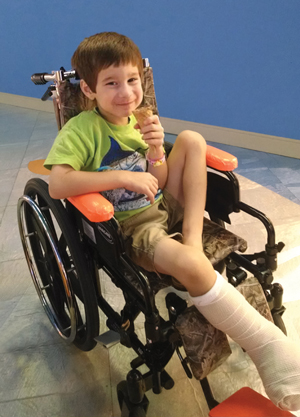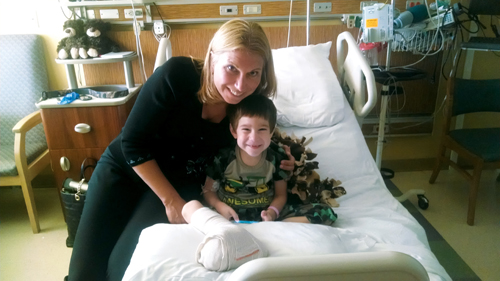 At first, little Landyn Gutierrez’s foot looked too horribly mangled to save. While the bottom surface and toes of the 3-year-old’s right foot were intact when he arrived at Children’s Hospital of The King’s Daughters last June, the entire top section – everything between his ankle and toe joints – had been shredded by a riding lawnmower. He was missing tissue and bone. The tendons to his toes were destroyed. The wound was filled with dirt and grass, leaving the preschooler at risk for a life-threatening infection.
At first, little Landyn Gutierrez’s foot looked too horribly mangled to save. While the bottom surface and toes of the 3-year-old’s right foot were intact when he arrived at Children’s Hospital of The King’s Daughters last June, the entire top section – everything between his ankle and toe joints – had been shredded by a riding lawnmower. He was missing tissue and bone. The tendons to his toes were destroyed. The wound was filled with dirt and grass, leaving the preschooler at risk for a life-threatening infection.
Landyn’s injury occurred at his family’s home in rural Hertford, N.C., when a family member accidentally ran over his foot with the mower.
Accidents like his are more common than most people realize, occurring approximately 17,000 times a year. Landyn had been helping his mother, Crystal, carry in groceries from her car. Landyn set his bags down in the kitchen and dashed back outside, with Crystal following close behind him. But as she reached the front door, she heard screaming.
“Landyn was still trying to run on his foot,” says Crystal. “There was blood everywhere.”
Crystal frantically dialed 911. Her husband, Jason, wrapped Landyn’s foot in a towel and applied pressure to his ankle to stem the bleeding. The couple put the child in the car and drove to meet an ambulance at a nearby gas station, which took Landyn to the local hospital. From there, Landyn was flown by helicopter to CHKD’s emergency room, where pediatric surgeons and specialists were standing by to assess his traumatic injury.
Dr. Allison Tenfelde, a pediatric orthopedic surgeon at CHKD, was on call that night. “This was an extremely complex and traumatic injury,” she recalls. “Looking at it, you couldn’t even discern the shape of a foot. I knew that we were facing a very real risk of having to amputate his foot.”
The immediate concern was avoiding infection. Lawnmower blades are covered with dirt and whirl at 3,000 revolutions per minute, driving debris deep into the wounds they cause. That night – and almost every day in the weeks that followed – Landyn went to the operating room to have his wound flushed with a high-powered saline spray and re-bandaged to avoid infection. Dr. Tenfelde and a team of CHKD pediatric surgeons, medical specialists, nurses, physical therapists and child life staff members connected with the family after every procedure to assess the current state of Landyn’s injury.
As the days passed, the risk of infection lessened, and Dr. Tenfelde consulted with multiple colleagues including Dr. George Hoerr, a pediatric plastic surgeon at CHKD, on how to repair the foot with the limited healthy soft tissue that had survived the accident. “Of course I wanted to see Landyn up and walking on his own foot, but it was always about what was best for him,” says Crystal. “They worried about Landyn like he was their own child.”
Unlike more common injuries, such as a fracture or sprain, severe pediatric trauma injuries are unique, and the healing process can be unpredictable. “Every case is completely different,” says Dr. Tenfelde. “There is no standard surgical approach to treating trauma cases like Landyn’s.”
Almost three weeks after the accident, Dr. Tenfelde operated on Landyn, hoping to reconstruct his foot. She trimmed and fused a combination of synthetic bone grafts and surviving bone before closing the wound. While she warned his family that his foot could be much smaller after surgery, Landyn lost only a half-inch of length in his injured foot.
“In general, children have better healing potential than adults,” says Dr. Tenfelde. “If this had been an adult patient, an attempt to save the foot might not have been made. Even with Landyn, it wasn’t clear at first whether we could or should save his foot. That was a big responsibility and required a very careful approach.”
 CHKD staff did their best to make the family feel comfortable during Landyn’s month-long stay in the pediatric intensive care and inpatient units.
CHKD staff did their best to make the family feel comfortable during Landyn’s month-long stay in the pediatric intensive care and inpatient units.
“Everyone, especially Dr. Tenfelde, just put their hearts into my son,” says Crystal. Dr. Tenfelde shared games on her cell phone with the little boy, and child life specialists talked with him and his upset siblings. Though he’d have months of physical therapy ahead of him, Landyn left CHKD after a month in the hospital … with both feet.
Due to the complexity of Landyn’s injury, Dr. Tenfelde was reluctant to celebrate fully until a follow-up appointment about nine months later.
“When I saw him running and jumping, I could breathe a sigh of relief,” she says. “He’s gone right back to his old self,” Crystal says. “He’s a handful. He runs, jumps down steps and jumps on both feet like nothing ever happened. It doesn’t hurt him at all.”
The family hopes their experience can raise awareness of the dangers posed by lawnmowers. CHKD sees at least one traumatic mower injury each summer, whether lacerations from blades, falls from riding mowers or wounds from kicked-up debris such as rocks and sticks. “It’s important to keep kids off of and away from all mowers,” Dr. Tenfelde advises. “Children should be inside when a lawnmower is going.”
Crystal is looking forward to putting the accident behind them and is thrilled to watch her youngest son back in action. “Landyn is so full of life,” she says. “I’m so grateful to CHKD.”